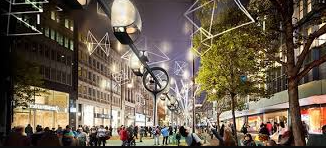
Sadiq Khan aims to revitalise Oxford Street with plans for partial pedestrianisation, challenging the Westminster council’s approach.
Sadiq Khan, the Mayor of London, has announced plans to take charge of Oxford Street’s future, accusing Westminster council of failing to revitalise the iconic shopping thoroughfare. Khan expressed his dissatisfaction with the current state of the street, stating that the council’s efforts have been inadequate to address the area’s decline.
In an interview following the launch of a public consultation on Oxford Street’s future, Khan criticised the council for not making the most of the street’s strategic importance. “Oxford Street is vital for both businesses and visitors,” he said, stressing the need to restore its status as a national asset.
The mayor proposes a new “mayoral development corporation” to oversee the transformation of Oxford Street, with plans to gradually remove traffic from parts of the street. This move comes after ongoing concerns from the Labour-led Westminster council, which Khan claims was previously an obstacle to progress. He is optimistic that the council will now support his vision for change, particularly given the street’s deteriorating condition and the rise of vacant, low-quality stores.
The proposed transformation includes plans for partial pedestrianisation, although full implementation would require further consultations and government approval. The consultation, set to run for nine weeks, seeks feedback on the principle of pedestrianising the street, as well as the establishment of the mayoral development corporation. Khan has also indicated interest in gaining control over parts of Oxford Street currently under Camden council’s jurisdiction.
Khan believes that Oxford Street has been negatively affected by factors such as the pandemic and the growth of online shopping. He envisions the area as a thriving, green, and accessible destination for both Londoners and tourists, suggesting that significant changes could improve air quality and reduce road dangers. While his proposals include pedestrianising certain sections of Oxford Street, he has not ruled out further transformations depending on the outcomes of the consultation process.
However, Westminster council has expressed reservations, stating that the establishment of a mayoral development corporation is not necessary. The council is willing to collaborate with Khan’s team, but it is committed to ensuring that the plans align with the needs of local residents and businesses.
The consultation documents propose a phased pedestrianisation plan that would start with the section between Oxford Circus and Orchard Street. Although Khan’s vision does not immediately include the full pedestrianisation of Oxford Street, he acknowledges that the area must evolve into a world-class public space to remain relevant in a changing retail landscape.
The project is expected to cost £150 million, but Khan has assured Londoners that the financial burden will not fall on taxpayers. He plans to explore private funding sources, including business contributions, developer input, and potential new revenue streams like advertising. Additionally, the mayor’s office is considering a new levy on businesses in the area to help cover the costs of the transformation.
While some critics argue that pedestrianisation alone will not solve the street’s problems, Khan remains focused on his long-term vision for Oxford Street. His proposals aim to make it a flagship destination that Londoners and visitors can take pride in, with benefits for local businesses, the economy, and the environment.




















Comments
Hello world!
Pic of the week: Sunset at margate beach
The first day’s journey was through the pink fields
The first day’s journey was through the pink fields
The first day’s journey was through the pink fields